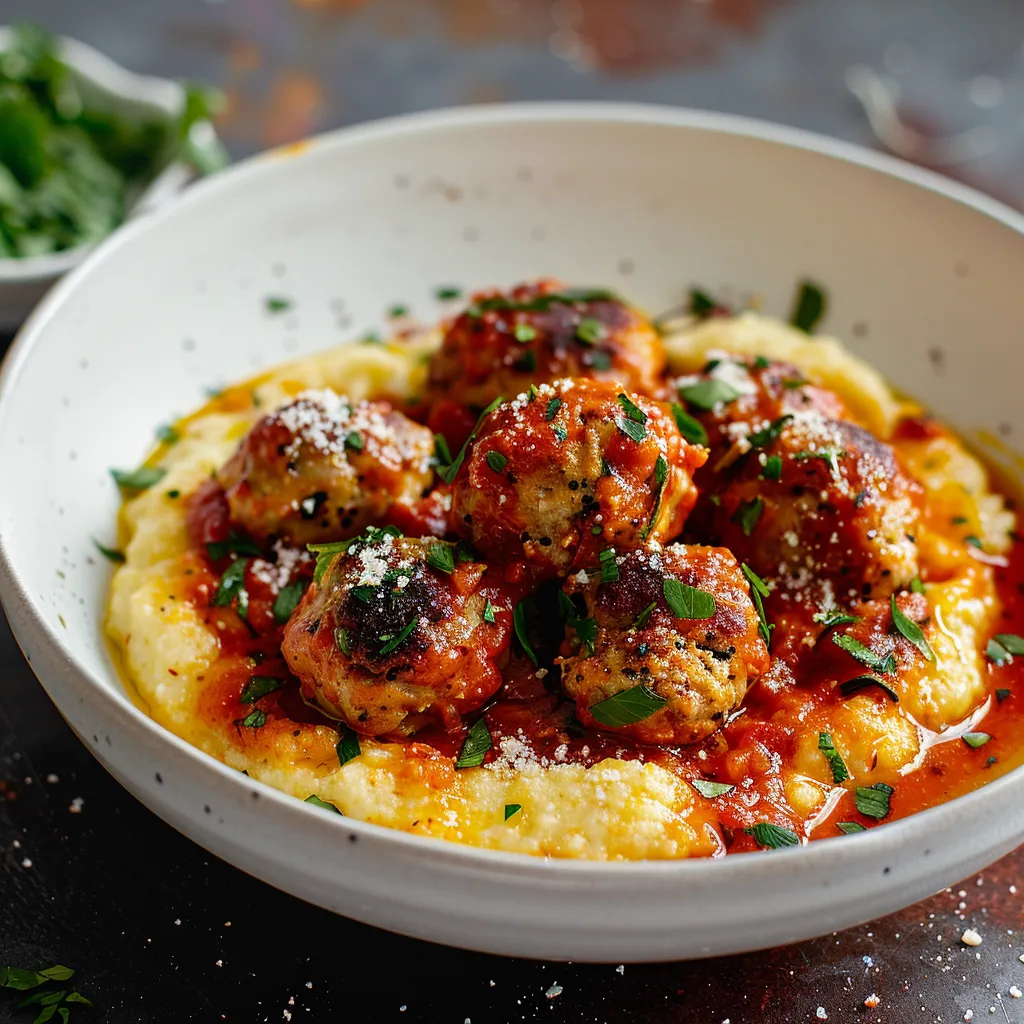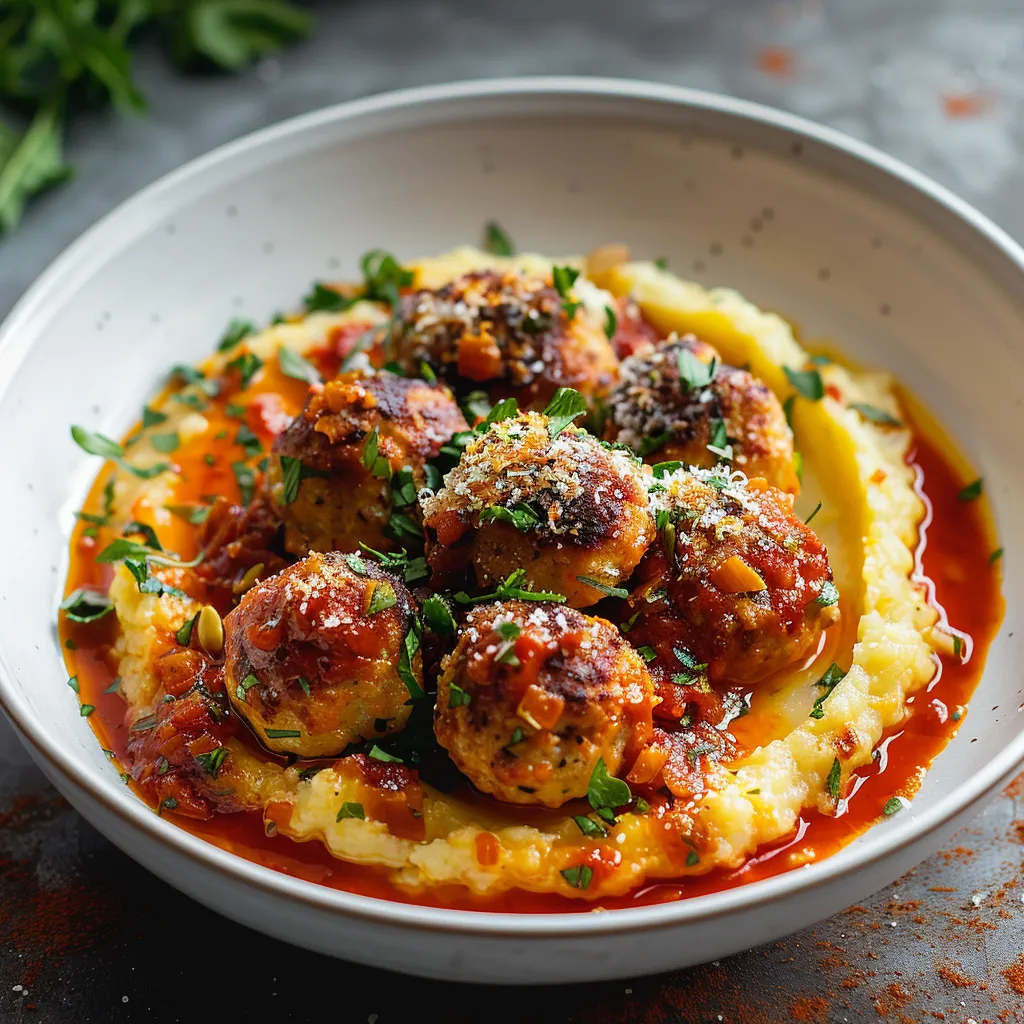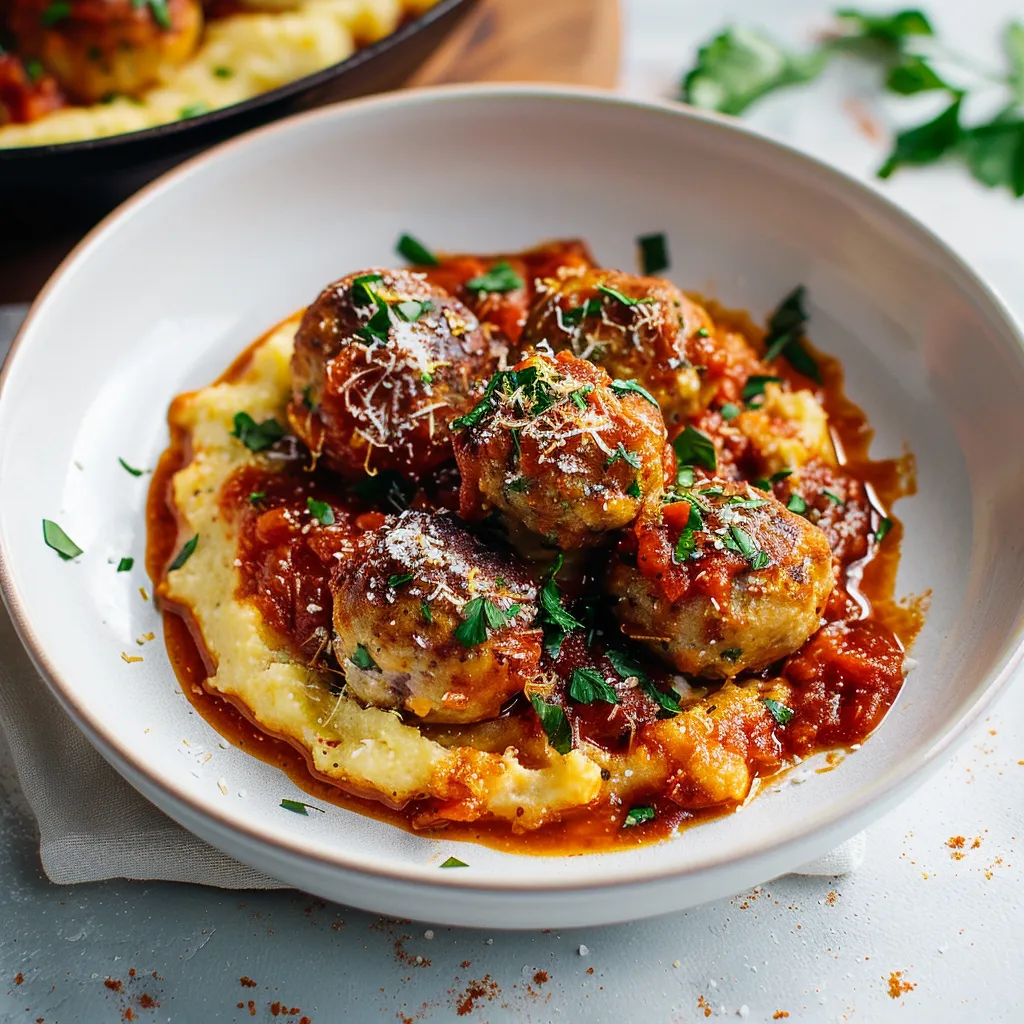 Pin it
Pin it
Chicken parmesan transforms into bite-sized meatball form in this cozy, comforting dish that brings restaurant quality to your dinner table. Ground chicken meatballs, seasoned with garlic, parmesan, and Italian herbs, simmer in a rich homemade tomato sauce before being nestled onto a bed of creamy, cheesy polenta. The combination creates an elegant yet approachable meal that feels special without requiring hours in the kitchen or advanced culinary skills. I discovered this dish while searching for alternatives to traditional pasta nights, and it's become a staple whenever I want to impress without stressing.
Last winter I prepared this for my sister and her husband during their visit, and they immediately requested the recipe before leaving. Something about the combination of tender meatballs against the smooth, creamy polenta creates a textural experience that feels indulgent while remaining surprisingly light compared to traditional pasta dishes.
Ingredient Selection Guide
- Panko breadcrumbs: Create lighter, more tender meatballs than standard breadcrumbs thanks to their airy, flaky texture.
- Fresh parsley: Brings brightness and color that dried simply cannot replicate, cutting through the richness beautifully.
- Ground chicken: Offers a leaner protein alternative that remains juicy when properly mixed and cooked.
- Italian crushed tomatoes: Contain less water than standard varieties, creating a naturally thicker, more flavorful sauce.
- Fennel seeds: Add a subtle anise flavor that complements the tomato sauce with unexpected complexity.
- Parmesan cheese: Incorporates into both meatballs and polenta, providing savory depth and unifying the dish.
- Polenta: Creates a silky, luxurious base that absorbs flavors better than pasta while offering unique textural contrast.
- Fresh garlic: Permeates every component with aromatic complexity that garlic powder simply cannot provide.
Meatball Creation Process
- Create The Binding Base:
- In a medium bowl, mix panko breadcrumbs with egg until thoroughly moistened, allowing the crumbs to soften slightly for two minutes before proceeding.
- Add Flavor Components:
- Incorporate grated parmesan, chopped fresh parsley, grated garlic, Italian seasoning, onion powder, red pepper flakes, salt and black pepper, mixing thoroughly to ensure even distribution.
- Introduce The Protein:
- Add ground chicken to the seasoned mixture, using your hands to gently fold everything together just until combined, being careful not to compress or overwork the meat which would result in tough meatballs.
- Form Perfect Portions:
- With slightly dampened hands to prevent sticking, scoop approximately one and a half tablespoons of mixture and gently roll between your palms to form uniform meatballs, placing them on a parchment-lined tray as you work.
- Create The Initial Sear:
- Heat olive oil in a large, heavy-bottomed skillet over medium-high heat until shimmering, then carefully add meatballs with space between each, working in batches if necessary to avoid overcrowding.
- Develop Golden Crust:
- Allow meatballs to cook undisturbed for about two minutes before gently turning to brown another side, continuing until most surfaces have developed a golden-brown crust while understanding they'll finish cooking in the sauce.
- Rest Before Saucing:
- Transfer seared meatballs to a plate, allowing them to rest briefly while you prepare the flavorful tomato sauce in the same skillet, preserving all the delicious browned bits.
 Pin it
Pin it
My family particularly enjoys the creamy polenta base in this recipe. Growing up in northern Italy, my grandmother would prepare polenta at least weekly during colder months, teaching me that constant stirring creates silky smoothness while preventing lumps. She insisted on using a wooden spoon with a flat edge to continuously scrape the bottom of the pot, a technique I still use today whenever preparing this comforting dish.
Sauce Creation Magic
The homemade tomato sauce elevates these chicken parmesan meatballs from everyday to exceptional. Using the same skillet where you seared the meatballs allows you to incorporate those flavorful browned bits directly into your sauce, creating depth that would otherwise be impossible. The addition of basil pesto introduces complex herbal notes without requiring multiple fresh herbs, while crushed fennel seeds provide subtle anise undertones that complement tomatoes beautifully. When simmering the meatballs in this luxurious sauce, they absorb moisture and flavor while simultaneously imparting their own essence back into the sauce. This reciprocal relationship between meatballs and sauce creates harmony that makes this dish particularly special and crave-worthy.
Perfecting Your Polenta
Creating truly exceptional polenta requires patience and attention to detail. The cooking liquid combination makes an enormous difference in the final texture and flavor profile. Using chicken broth provides savory depth while milk and cream contribute richness and silkiness impossible to achieve with water alone. Start with cold liquid and add polenta in a thin, steady stream while whisking continuously to prevent lumps from forming. The key to perfect polenta texture lies in maintaining a gentle simmer rather than a rolling boil, which prevents the mixture from splattering while allowing the cornmeal to gradually absorb liquid and release its starches.
 Pin it
Pin it
Frequently Asked Questions
- → Can I use regular breadcrumbs instead of panko?
- Yes, you can substitute regular breadcrumbs for panko, though the texture of the meatballs may be slightly denser. If using regular breadcrumbs, reduce the amount to ⅔ cup since they're more compact than panko.
- → How do I know when the meatballs are fully cooked?
- Chicken meatballs are fully cooked when they reach an internal temperature of 165°F. If you don't have a meat thermometer, cut one open - the meat should be completely opaque with no pink remaining.
- → Can I make this dish ahead of time?
- You can prepare the meatballs and sauce up to a day ahead and refrigerate. Reheat gently on the stove before serving. The polenta is best made fresh, as it thickens considerably when cooled, though it can be reheated with additional liquid to thin it out.
- → What can I substitute for polenta?
- If you don't have polenta, this dish works beautifully with pasta, particularly spaghetti or pappardelle. Mashed potatoes or even crusty bread for dipping into the sauce are also delicious alternatives.
- → Can I freeze the meatballs?
- Yes! You can freeze the cooked meatballs and sauce for up to 3 months. Thaw overnight in the refrigerator and reheat gently on the stovetop. The polenta doesn't freeze well, so make that fresh when ready to serve.
- → Is there a way to make this recipe gluten-free?
- Absolutely! Simply substitute the panko breadcrumbs with gluten-free breadcrumbs or crushed gluten-free crackers. The polenta is naturally gluten-free, just verify your broth doesn't contain any gluten ingredients.
